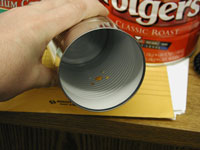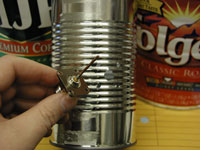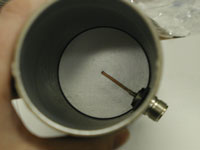Assemble the probe and mount in can
Now you'll need that bit of wire. You'll need a soldering iron or a friend
with one as well. Cut the wire so that when it is stuck in the connector
as shown, the total length of both the brass tube and wire sticking out
past the connector is 1.21". Get as close to this length as you can.
When you've got your wire correctly sized, solder it into the connector
keeping it as straight and upright as you can. When it's cooled, bolt
or screw the assembly into your can. Put the heads of the bolts inside
the can and the nuts on the outside to minimize the obstructions in your
antenna. Your Done!
Connect your antenna to your wireless card or access point
To use your cantenna, you'll need a special cable commonly called a "Pig
Tail". The pig tail connects your wireless card or access point to
you antenna. One end of the cable will have a "N" Male connector
(just right for connecting your your cantenna), while the other end will
have a connector appropriate to your card or access point. For a good
picture of a pig tail, take a look at:
http://www.seattlewireless.net/index.cgi?PigTail
You'll want to have a wireless NIC or access point with an external antenna
connector. Otherwise, you may have to hack into the one you have to hook
up the cable. I wouldn't recommend this unless you're good with a soldering
iron and electronics. For this reason, I like the Agere Orinoco cards
which have a nice antenna connector. Pig Tails can be hand made if you
have the right tools, but it's probably easier to get a pre-made one.
Try:
Hook up your cable, point the antenna at a friend's, and see how far
you can stretch you network. Be sure to let me know (greg@turnpoint.net)
how it works.
This antenna has linear polarization. That means that how you rotate
the antenna will affect the strength of your signal. Usually, you will
want to put the connection straight down, but experiment with rotating
the can while watching the signal strength on your PC to get the best
performance.
For more information, check out these resources:
|








